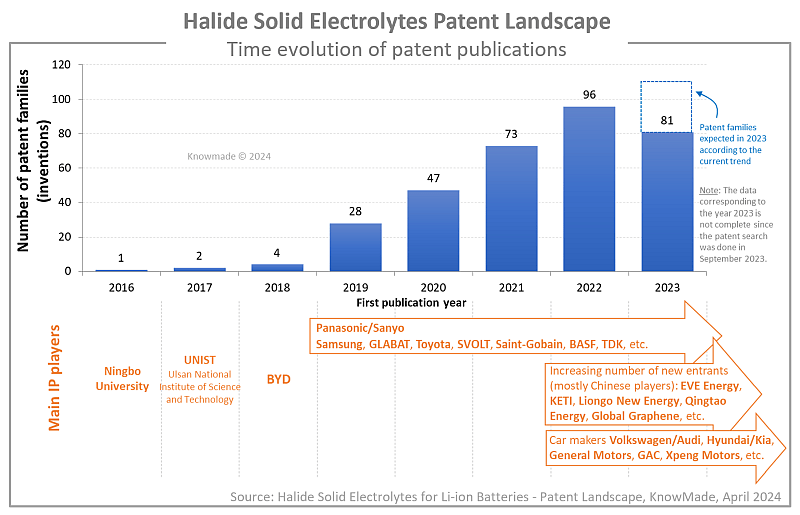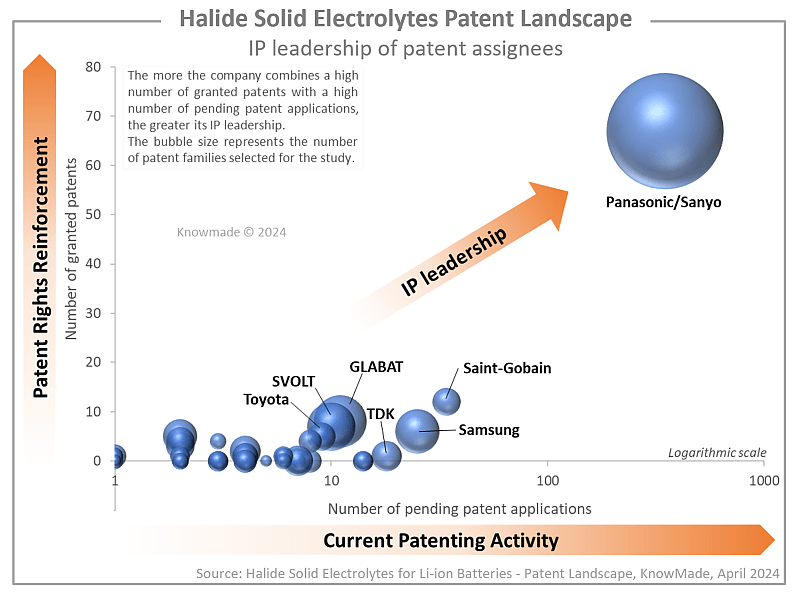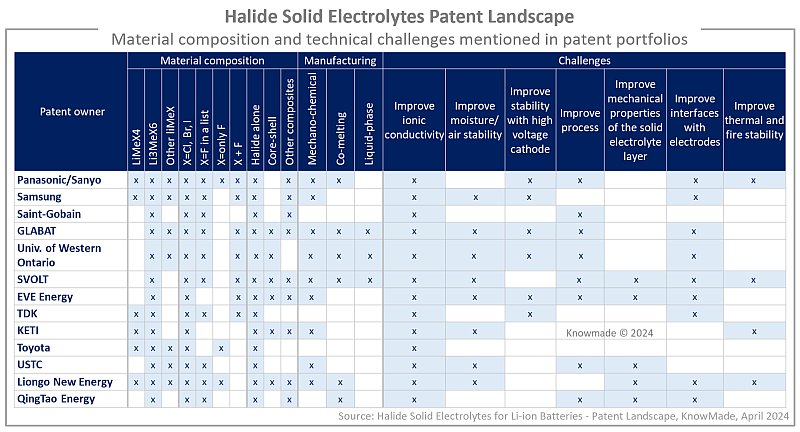
Patented technologies and nascent IP competition for emerging halide solid electrolyte materials
Publication May 2024
| Download Flyer | Download Sample |
KEY FEATURES
- PDF >90 slides
- Excel file >300 patent families
- Global patenting trends, including time evolution of patent publications, countries of patent filings, etc.
- Main patent assignees and IP newcomers in the different segments of the supply chain.
- Key players’ IP position and the relative strength of their patent portfolio.
- Patents categorized by material composition and technical challenges.
- IP profile of key players (patent portfolio overview, technical coverage, geographical coverage, key patents, etc.)
- Excel database containing all patents analyzed in the report, including patent segmentations and hyperlinks to an updated online database.
KnowMade’s battery expertise extends to
- Solid-State Li-ion Batteries with Inorganic Solid Electrolytes – Patent Landscape Report
- Solid Electrolytes for Li-ion Solid-State Batteries – Patent Landscape Report
- Solid-State Batteries – Patent Monitoring Service (annual subscription)
Halide solid electrolytes are promising options for solid-state batteries
Solid-state Li-ion batteries have garnered significant attention in recent decades due to their notable advantages of safety and potential for high energy density. Solid electrolytes (SE) with rapid ionic transport and excellent stability are essential for the commercialization of this promising next-generation of Lithium batteries. Hence, there has been extensive exploration of inorganic solid electrolytes, including sulfide- and oxide-based electrolytes. Unfortunately, both have been unable to strike an optimal balance between conductivity and stability. Oxides suffer from high impedance of grain boundaries, while sulfides experience poor stability. However, halide-based solid electrolytes are increasingly being recognized as one of the most promising options for solid-state Li-ion batteries, owing to their decent room temperature ionic conductivity (>10−3 S.cm−1), good compatibility with oxide cathode materials, excellent chemical stability, and scalability.
The increasing interest in halide solid electrolytes has been observed while monitoring patents on solid-state Li-ion batteries. As of September 2023, over 330 patent families have been published on halide solid electrolyte materials for Li-ion batteries. It is now crucial for companies operating in the solid-state battery industry to closely examine these emerging materials from technological, competitive, and intellectual property (IP) perspectives.
In this context, Knowmade is releasing a new patent landscape report that focuses on halide solid electrolyte materials for Li-ion batteries. In this report, Knowmade’s analysts have selected and analyzed over 860 patents and patent applications from more than 330 patent families (inventions) filed by 110+ different entities. The report provides a detailed analysis of the IP landscape and noteworthy patents concerning halide solid electrolyte materials. This new IP report is complementary to our previous patent landscape reports and patent monitors on solid-state batteries.

Understanding the main trends, the key players’ IP position and IP strategy
IP competition analysis should reflect the vision of players with a strategy to enter and develop their business in the solid-state Li-ion battery market. In this report, Knowmade’s analysts provide a comprehensive overview of the competitive IP landscape and latest technological developments in this field. The report covers IP dynamics and key trends in terms of patents applications, patent assignees, filing countries, and patented technologies. It also identifies the IP leaders, most active patent applicants, and new entrants in the IP landscape. The report also sheds light on under-the-radar companies and new players in this field.
What are the patented technologies?

In this report, we analyze the strength of patent portfolios and the technology and application focus of key patent assignees. An overview of the current status and trends of patented technologies and their applications is also provided. Furthermore, the report examines the strategic and technological directions of both leading companies and newcomers in the field.
The patents have been manually categorized according the claimed material compositions (LiMX4, Li3MX6, halide material alone, halide material with a shell, halide material mixed with another material), the claimed manufacturing methods (mechano-chemical, co-melting, liquid-phase), as well as the challenges/solutions and the best materials/ionic conductivities at room temperature disclosed by the inventions.
A few IP leaders and numerous IP newcomers
Panasonic/Sanyo is leading the halide solid electrolytes patent landscape, challenged by Samsung, GLABAT, SVOLT, Saint-Gobain, and TDK. Additionally, the IP analysis allowed us to pinpoint over 60 IP newcomers who filed their first halide-related patents in 2022 or after: EVE Energy, Korea Electronics Technology Institute (KETI), Liongo New Energy, Qingtao Energy Development, Global Graphene, etc. 80% of new entrants in the patent landscape come from China. In a dedicated section, we focus on the IP portfolios held by key players (Panasonic, Samsung, Saint-Gobain, GLABAT, SVOLT, EVE Energy, University of Western Ontario, TDK, Toyota, etc.). For each, we provide an overview of their patent portfolio related to halide solid electrolytes and a description of their key patented technologies.

Useful Excel patent database
This report also includes an extensive Excel database with all patents analyzed in this study. This useful patent database allows for multi-criteria searches and includes patent publication numbers, hyperlinks to an updated online database (original documents, legal status, etc.), priority date, title, abstract, patent assignees, and segments (challenges/solutions, material composition, halide formula, synthesis methods, etc.).
Companies mentioned in the report (non-exhaustive)
Baoneng Group, Baowu Steel Group, BASF, Beijing Institute of Technology, BYD, China Automotive Battery Research Institute, China Electrics, Corning, EVE Energy, FAW (China First Automobile Works), Global Graphene, GRINM (General Research Institute for Nonferrous Metals) / GRIMAT, GRIREM Advanced Materials, GTC Power, Guolian Automobile Power Battery Research Institute (GLABAT), Guoxuan High Tech Power Energy / Gotion, Hanyang University, Hyundai / Kia, Institute of Chemistry – Chinese Academy of Sciences, Korea Electronics Technology Institute (KETI), Liongo New Energy Technology, Nankai University, Nanmu Nanotechnology, Nichia, Panasonic / Sanyo, QingTao Energy Development, Rare Earth Functional Materials Innovation Center, Saint-Gobain, Samsung, Shenzhen University, Silver Leaf Element, Solvay, South University of Science & Technology of China (SUSTech), SVOLT / Fengchao Energy Technology, TDK, Toyota, Tsinghua Shenzhen International Graduate School, University of Maryland, University of Waterloo, University of Western Ontario, University of Science and Technology of China (USTC), Xi’an Jiaotong University, Yonsei University, Zengzhou New Century Materials Genome Institute, Zhejiang University, and more.
